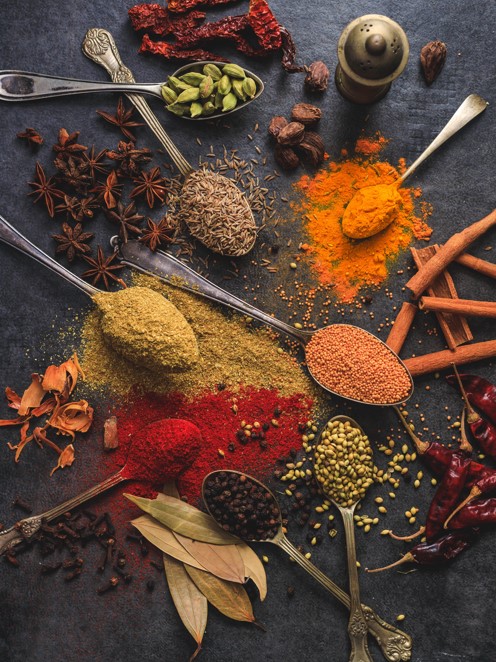The discovery of spices and herbs, in particular the trade of these ingredients, was a defining moment in world history. Firstly, because spices and herbs enhanced the culinary experience, and secondly, it was the start of a global economy.
In ancient times, spices and herbs was an important commodity. Perfumes made from the aromatic plants adorned the bodies of the wealthy and kings. Often, spices were used as a form of currency or exchange, making them just as valuable as gold.
Ancient Egyptians used caraway, coriander, fennel, garlic, mint, peppermint, and poppy for many different medicinal applications and treatments. Some of these include the embalming of deceased individuals for mummification. Cardamom and cinnamon from Ethiopia were also a delicacy that spiced up their diets.

Herbs, the leaves of aromatic plants, were also traded as spices. This collection of compounds changed cuisine forever. (Source: Alleksana on pexels)
During Biblical times, the importance of spice was documented. Salt, for instance, is a vital part of ensuring a dish does not taste bland. Other spices were used as a fragrant skin treatment and perfume, or oils extracted from the plants were used for religious practices such as anointings.
Spice (used here as a collective for both spice and herbs) was strongly positioned as an important commodity in the Middle-East by the Age of Exploration and it made its way to the west through the Silk Road. Merchants who travelled through Middle-Eastern countries towards Europe brought with them beautiful silk garments and spices from the East.

Spices have been a sought-after flavour enhancer since antiquity. (Source: Pexels)
But this way of trade was costly to the people in the West, because most often they needed to purchase the aromatics from the Arabs, not directly from the countries the spices originated from. Needing to travel across many countries on the silk road meant a strenuous journey that was filled with danger and politics driven by the desire of many leaders to have the spices for themselves.
European kings and rulers started to investigate other avenues of obtaining the substances without needing to rely on all the middlemen. Thus began the Age of Exploration. This era was marked by many voyages by European explorers to attempt to find an alternative route to the East-Indies. One of the explorers included Vasco da Gama from Portugal who eventually succeeded in rounding the tip of Africa.

A Renaissance painting of Vasco da Gama in the Museu Nacional de Arte Antiga in Portugal. (Source: Wikicommons)
During his journeys along the coast of Africa, Da Gama learnt many things. While he stopped over in Kenya, he saw both the spices and the Indian merchants who brought the aromatics with them. This was proof that the spice trade in Africa was already alive and well. He continued his expeditions around the coast of Africa and finally made it to India after years of trying.
The spice trade route around Africa was born.
As the demand for spice and herbs grew in Europe, Asia could not keep up with supply.
Portugal gained control of the African spice route through the annexation of Tanzania, which included Zanzibar at the time. The area’s tropical climate, rich soil and access to a trade route made it the ideal place for cultivating the aromatics, mainly nutmeg, pepper, ginger, and cloves. Many of the spice crops were planted on the slopes of the Eastern Arc, a mountain range close to the coast of Tanzania.
By the 19th century, Zanzibar was the leading exporter of spice.

Herbs contain many medicinal and nutritional benefits. (Source: Pixabay)
Further migration of East-African and middle-Eastern inhabitants deeper to the west, as well as the exploitation of these countries by the West lead to the introduction of more plants used for spice and herb production.
Cultivation, although not very well documented, followed throughout Africa. Plants from around the globe, from Asia, the middle-east, and even South America, were brought to the continent.
Omani Arabs began spice farming in Eastern Africa. Today, their heritage remains in the delicious dishes of eastern African cuisine.
It is important to note that the impact spice had in Europe, and Africa for that matter, was more than just a flavour enhancer for food. It became a useful addition to medicines and many of the plants are still praised for their medicinal qualities today.

Spices in containers at an African market. (Source: Pixabay)
Some such as cinnamon is antibacterial, anti-inflammatory, and antimicrobial. Black pepper can soothe indigestion and sage can help wounds from becoming septic.
Beyond the health benefits of the spices, the plants have a variety of nutritional benefits. Consumers therefore also added micronutrients to their diets when consuming these ingredients.
References
Cartwright, M. 2023. The Spice Trade & The Age of Exploration https://www.worldhistory.org#organization. Available: https://www.worldhistory.org/article/1777/the-spice-trade–the-age-of-exploration/
Herbs and spices. 2022. Agribook Digital. Available: https://www.agribook.co.za/forestry-and-industrial-crops/herbs-and-spices/
History: Spice Islands, Colonization & Spice Trade in Tanzania. n.d. Available: https://www.tanzaniaspices.org/history
McCormick Science Institute. 2022. History of spices. Available: https://www.mccormickscienceinstitute.com/resources/history-of-spices









